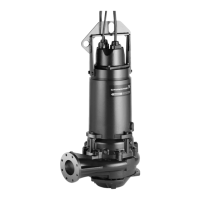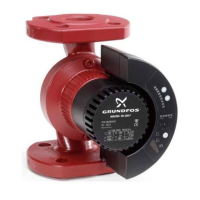English (GB)
14
8.7.3 Checking the insulation resistance
Insulation resistance can be measured from the cable end
(control cabinet) or from the stator wires. Use a tester that can
apply at least 500 VDC.
1. Measure the insulation resistance. As a minimum there must
be 100 MΩ between:
– earth (body) to phases U, V and W
– earth (body) to control circuit leads P1 and P2 (1 and 2)
– control circuit leads P1 and P2 to phases U, V and W
– between phases.
2. If any of the above-mentioned measurements are below 100
MΩ, measure cable, windings and devices separately to find
out where the insulation resistance has decreased.
Reduction of insulation resistance due to moisture requires
drying of the relevant parts, see sections 8.7.5 Drying of the
cable and 8.7.6 Drying of the stator and the rotor.
3. Check that the conductor markings are indicated at the end of
the cables.
8.7.4 Checking the stator winding resistance
The measurements can be performed with a reliable multimeter
that is capable of measuring Ω-values with 3 digit accuracy.
The maximum allowed difference between phases is ± 10 %.
Proceed as follows:
1. Disconnect the stator winding wire ends from the terminal
board.
2. Identify the wire markings and proceed according to step 3 or
step 4.
Step 3 applies only for the wires marked with the letters U, V and
W.
3. Measure the stator winding resistance between:
– U1 and U2
– V1 and V2
– W1 and W2.
Step 4 applies only for the wires marked with the letter T.
4. Measure the stator winding resistance between:
– T1 and T4
– T2 and T5
– T3 and T6
– T7 and T8 (2 phases in series)
– T8 and T9 (2 phases in series)
– T9 and T7 (2 phases in series).
5. Compare the measured values to the values in the winding
resistance value table. See section 11.4.1 Cable and winding
resistances. In case of 2 phases in series, the measured
values need to be divided by 2 before comparing them to the
values in the tables.
If no or only very few readings are obtained, the stator must
be dried before the measurements are carried out again. See
section 8.7.6 Drying of the stator and the rotor.
Consistent false reading of the stator winding resistance
values is sufficient evidence of a winding damage. In case the
stator needs to be replaced, see section 9. Dismantling and
assembly instructions.
8.7.5 Drying of the cable
1. See section 9.3.5 Removing the motor top cover.
2. See section 9.1 Checking and replacing the cable.
3. Blow clean air (max. 0.8 bar) through the cable.
4. Dry for approx. 20 hours.
5. Connect the old cable or replace it with a new one.
6. Measure the resistance. See section 8.7.3 Checking the
insulation resistance.
8.7.6 Drying of the stator and the rotor
1. See section 9. Dismantling and assembly instructions.
2. Place the stator and rotor in an oven at 100-110 °C.
3. Dry for 6 to 12 hours.
4. Let the stator and rotor cool down.
5. Measure the winding resistance.
If the measurements are not valid, replace the stator. See
section 9.3.12 Removing the stator.
6. See section 9. Dismantling and assembly instructions.
Always disconnect the stator winding wires from the
terminal board before measuring resistance values
from them.
Make sure that the cables are disconnected from the
terminal board before removing the cable entry.
If the stator is wet, not only the stator but also the
rotor must be dried. If this is not done, the stator may
become moist again after re-assembly and trip the
moisture switch.

